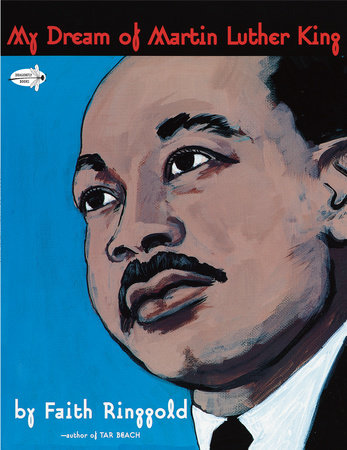TEACHING GUIDE
ABOUT THIS BOOKInspired by people who have overcome adversity, Faith Ringgold creates picture books for children that celebrate freedom, courage, and peace.
In My Dream of Martin Luther King, readers encounter boycotts, sit-ins, demonstrations, marches, and the 1968 assassination of Dr. Martin Luther King, Jr., Ringgold stresses the events that led to King’s "peaceful" fight to gain civil rights for all African Americans, and challenges readers to continue his dream.
ABOUT THIS AUTHORFaith Ringgold was born in Harlem in 1930. She received a degree in art education from the City College of New York and was an art teacher long before she became a professional artist. She is best known for her "painted story quilts," some of which hang in the Solomon R. Guggenheim Museum in New York City. Tar Beach, Ringgold’s first book for children, won the Coretta Scott King Award for illustration and was named a Caldecott Honor Book. Ringgold is now a professor of art at the University of California at San Diego. She lives in California and in New Jersey.
TEACHING IDEASPre-Reading Activity Discuss the meaning of the familiar expression, "free as a bird." Ask students to write a short composition or poem about where they would fly if they had the freedom and ability to do so. Give each student a paper square and ask them to design a quilt square that best represents their idea. Use the quilt squares to make a border surrounding a display of students’ written works.
Thematic Connections DreamsDiscuss with the class the difference between fanciful and realistic dreams. Why would Cassie Lightfoot’s dream in Tar Beach be considered a fanciful dream? Tell students that many of the changes that have occurred in the world began with a dream. Ask the class to discuss Martin Luther King, Jr.’s dream for the world. What was Harriet Tubman’s dream? Compare Mama Love’s fanciful dream in The Invisible Princess to Dr. King’s "real" dream. How did Martin Luther King, Jr. help the dreams of his ancestors come true?
CourageAsk students to define courage. Why does it take courage to become a hero or a heroine? Invite the class to name the many ways that Martin Luther King, Jr., Harriet Tubman, and Patience in The Invisible Princess showed courage.
PeaceIn The Invisible Princess, "the Great Lady of Peace" teaches the princess to be "loving, strong, and wise." How do these human qualities relate to peace? Read aloud My Dream of Martin Luther King and ask students to discuss how Dr. King was loving, strong, and wise. What did Mahatma Gandhi teach Dr. King about peace? What could we learn from the messages of these two great men?
Interdisciplinary Connections Language ArtsThe Invisible Princess is an original fairy tale. Tell the class that the conflict in most fairy tales is good vs. evil. Ask students to identify each of these elements in Ringgold’s story. Read aloud My Dream of Martin Luther King. Tell the class that fairy tales originated from dreams. Discuss Martin Luther King, Jr.’s dream. Then have students write or tell a fairy tale that Dr. King might have told to the children of the world.
How are names like Village of Visible, Mama and Papa Love, Great Lady of Peace, Captain Pepper, and Patience symbolic in the story of The Invisible Princess?
Science Cotton was grown on most of the large plantations in the South. Ask students to research how the invention of the cotton gin changed the industry and how cotton is harvested today. Students may also want to trace the development of the cotton mills and list the uses of cotton.
One Step Beyond: The Arts Creative Drama Martin Luther King, Jr. is famous for his "I Have a Dream" speech. Plan a class production entitled "Dreams of Freedom," making Cassie Lightfoot the narrator. Ask students to research famous African Americans and their contributions to "freedom" for their race. Some suggestions may include: Dr. Martin Luther King, Jr., Harriet Tubman, Sojourner Truth, Ida Wells, Mary McLeod Bethune, Rosa Parks, and Coretta Scott King. Have students prepare and deliver speeches about "freedom" that each of these individuals might make. Present this production to another class in celebration of Black History Month.
Teaching Ideas prepared by Pat Scales, Director of Library Services of the South Carolina Governor’s School for the Arts and Humanities in Greenville, SC.
VOCABULARYAsk students to list unfamiliar words in each book and try to define the words from the context of the stories. Words they may need to discuss in The Invisible Princess include repentance, tumultuous, and remorse. Students may need discussion regarding terms that refer to slavery and the civil rights movement, including: conductor, slave master, overseers, boycott, fugitives, segregation, and integration.
FURTHER READINGAunt Harriet’s Underground Railroad in the Sky by Faith Ringgold[0-517-88543-3]
The Invisible Princess by Faith Ringgold; illustrated by the author[0-517-80024-1]
Talking to Faith Ringgold by Freeman; Faith Ringgold[0-517-88546-8]
Tar Beach by Faith Ringgold[0-517-58030-6]

